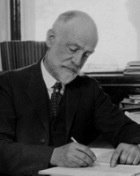William F. Durand
William F. Durand — aerodynamics pioneer

William Durand (1859-1958), one of the most revered engineers in Stanford history, was a pioneer in aeronautics, naval propulsion and engineering research methods. A picket-fence display of his hand-carved wooden propeller designs graces a wall of the Terman Library at the Huang Engineering Center.
Durand joined the Stanford faculty as a professor in 1904 and began studying the then-nascent field of aviation. Working with Professor E.P. Lesley, Durand built one of the first wind tunnels and launched a rigorous study of propeller design that helped airplane makers choose the best props for their airframe designs.
In the early 1930s, Durand edited the six-volume series “Aerodynamic Theory,” a major reference in the field. Durand served as chairman of the National Advisory Committee for Aeronautics — a precursor of NASA — and led a program during World War II to advance the development of jet engines.
